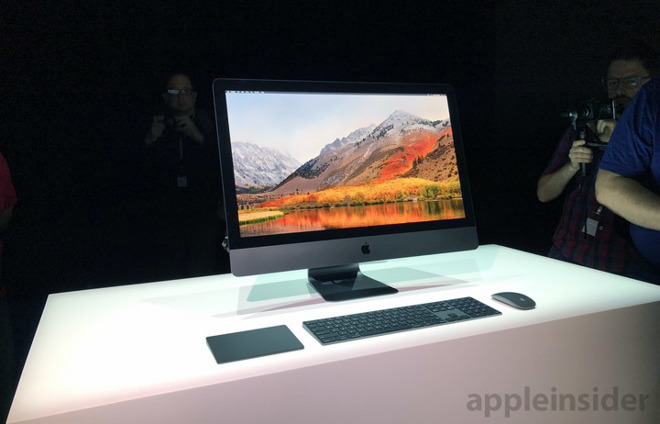The iMac Pro may have an A10 Fusion processor running it's own iOS, called BridgeOS, to handle some functions — notably 'Hey Siri'.
Guilherme Rambo and Stephen Troughton-Smith have been exploring macOS and have found 'Hey Siri' functionality in the code base with support for multiple user accounts, just as macOS has long supported user switching.
Looks like the iMac Pro's ARM coprocessor is arm64 Seems to handle the macOS boot & security process, as expected; iMac Pro lets Apple experiment with tighter control without the rest of the userbase freaking out. More info & download here: https://t.co/wmbNeVSEZX
— Steve Troughton-Smith (@stroughtonsmith) November 18, 2017
If the accounts are correct, It looks as though the ARM coprocessor takes over the boot process, security, and the FaceTime camera. It also appears that the inclusion of the A10 Fusion allows the iMac Pro to accept the voice command 'Hey Siri' rather than requiring the click in macOS on the Siri icon or keystroke to prompt Siri.
The "Hey Siri" setup on macOS is identical to the one on iOS, but it's implemented with regular AppKit, there's no magical UIKit port or UXKit being used pic.twitter.com/lhuga3dA7y
— Guilherme Rambo (@_inside) November 19, 2017
"Hey Siri" on macOS depends on the presence of a BridgeOS device (A10 coprocessor).
— Guilherme Rambo (@_inside) November 19, 2017
"Hey Siri" enrollment model from my testing yesterday was stored in ~/Library/VoiceTrigger/SAT. Means it's going to support multiple users.
— Guilherme Rambo (@_inside) November 19, 2017
This doesn't mean necessarily that Siri will understand multiple users speaking while logged into one macOS user account. But, it may mean that if a user has multiple accounts on a Mac, they should be able to fast user switch between them and have the iMac Pro recognize 'Hey Siri' for each of them.
It is unclear if this functionality will need a coprocessor like the A10 Fusion to be implemented in other machines.
 Victor Marks
Victor Marks







-m.jpg)






 Christine McKee
Christine McKee
 Marko Zivkovic
Marko Zivkovic
 Mike Wuerthele
Mike Wuerthele

 Amber Neely
Amber Neely
 Sponsored Content
Sponsored Content
 Wesley Hilliard
Wesley Hilliard









92 Comments
1) I think bridgeOS is also what Apple calls the OS on their T1 chip for the Touch Bar, Touch ID, and Apple Pay in their MacBook Pros.
2) I'm curious why the 'B' is being capitalized when all other Apple OSes have the first letter lowercase.
3) A10 seems like overkill for the stated functionality, and with FaceTime mentioned I hope that this means the iMac Pro will also include Face ID.
4) Is this still launching next month?
I always find it easier and quicker to just do a search using a few keys than talking to a digital assistant which works once out of seven attempts. We don't need Siri, stop trying to make us all lazy and lame.
The A10 fusion chip is cheap compared to the Intel chips. The iMac pro margin can easily handle it.
Apple could be working towards direct running of iOS apps on OS X for development or plain ol' operation. Your Mac could become your iPad or your phone... just another iOS device, while still being a Mac.
At the same time, Apple could be testing how well the ARM runs pro-style apps or OSX. If the A10 chip is handling the boot process, then the next step is booting to the OS of choice, be it OSX, Windows, or (dun dun dunnnn...) iOS.
Remember that Apple was running OSX on intel for FIVE YEARS before they ANNOUNCED the switch to Intel. We could have ARM-based Macs in that time or less from now.
It sounds nuts. N-V-T-S, nuts. But it is plausible.
I usually disable Siri on the Mac...its just too useless. I don't see where it really does much of anything.
I think it would be cool to see the A10 or A11 in the next MacBook and/or MacBook Pro along side the Intel CPU. It could run the OS doing basic things and then when power is really needed it kicks in the Intel CPU. That would quite a feat of engineering though. There's a lot of software engineering that needs to take place to make something like that work reliably.